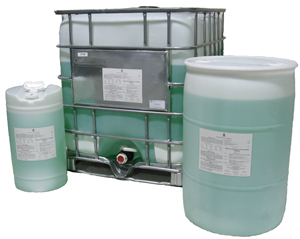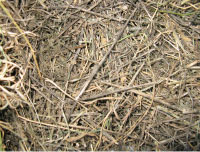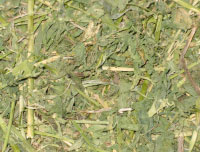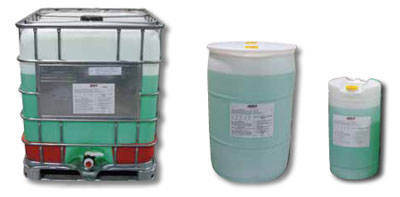
![]()
Your hay is important. Make sure your preservative does what it says it will.
Check out our NEW ROI Calculator!
Features & Benefits
- Bale at moistures up to 30%
- Effective on all types of hay, including alfalfa, timothy and other grasses
- Maintains hay's green color and fresh natural smell
- Neutral pH of 6.0 won t corrode baling equipment
- Safe for all livestock
CaseIH Thirty-Plus Preservative is ordered directly through your local CaseIH dealership.
| Part Number | Description | Canada PN | Description |
| C0903 | Mini Drum - 13 Gal. / 120 Lbs US | C0903C | Mini Drum - 13 Gal. / 120 Lbs US |
| C0904 | Drum* - 50 Gal. / 450 Lbs US | C0904C | Drum* - 50 Gal. / 450 Lbs US |
| C0908 | Tote - 200 Gal. / 1,800 Lbs US | C0909C | Large Tote - 265 / 2,380 Lbs US |
| C0909 | Large Tote - 265 / 2,380 Lbs US |
*Drums not available in California


Why does hay spoil?
Mold
At moistures 17% to 30%, mold, fungi and yeasts start to multiply, consisting of mycelium and spores, giving the hay a white and dusty appearance, and can also produce harmful mycotoxins. Mold growth also causes heating.
Heat
- Hay baled at moistures 17% to 22% will heat to over 115°F, enough to cause discoloration and loss of the hay’s fresh smell
- Between 23% and 26% hay can reach temps of over 125°F in storage causing brown to black hay with carmelized mold
Moisture levels of over 27% can result in heating to over 140°F and above, and may even combust.
Value of higher moisture hay
Baling Alfalfa at 22% vs. 14% moisture
More tons of dry matter harvested +10%
Extra weight from moisture retained +4%
Total +14%
24 points higher relative feed value
“Mechanical Properties Affecting Leaf Loss in Alfalfa”, W.K. Bilanski, CANADIAN AGRICULTURAL ENGINEERING, Vol. 15, No. 1, June 1973
How Thirty Plus works - Ingredients
Propionic Acid- Buffered so it had a neutral pH avoiding corrosion, yet it is still effective enough to stop the growth of mold and prevent heating
Citric Acid- Helps maintain both the fresh smell and green color of hay, even after it’s stored
Surfactant- Makes particle size uniform for even dispersing and less risk of under application due to wind drift
Benefits of using Thirty Plus
- No more waiting on the weather, bale when you’re ready at moistures up to 30%
- Start working earlier in the day and later in the evening
- Bale at higher moistures without worry of heating or mold damage
- Hay treated with Thirty Plus is greener and higher in feed value
- When compared to dry preservatives and inoculants, Thirty Plus is easier to apply, gives more consistent coverage, and won’t clog application equipment
- Works well on ALL types of hay
- Non-corrosive buffered formula won’t harm expensive baling equipment, the user, or livestock
- Thirty Plus treated hay can be stored for years and will look and feed as well as when it was first baled
- Thirty Plus is ok to store outside as it won’t freeze and won’t lose effectiveness over time
Thirty Plus Hay Preservative Ingredients |
|
|---|---|
| Active Ingredient Propionic Acid Citric Acid |
64.5% 5.0% |
| Other Ingredients Ammonium Hydroxide, Deionized Water, Dodecylphol Ethoxylate, Green Dyes |
30.5% |
| EPA Registration #73877-1-74898 | Total 100% |
Click HERE for the Case IH Thirty Plus SDS (Safety Data Sheet)
Available sizes
| Totes | Drum | Mini Drum | |
| 1,800 lbs./200 Gal.* 818 kg/757 L |
2,380 lbs./270 Gal. 1,082 kg/1,020 L |
450 lbs./50 Gal. 204 kg/189.3 L |
120 lbs./15 Gal. 54 kg/50.5 L |
| *Not Available in Canada | |||
Application RatesLarge Square Bales |
||
|---|---|---|
| Hay Moisture | Stem Moisture | Dew Moisture Only |
| Under 22% | 6 lbs/ton | 3 lbs/ton |
| 23% - 26% | 10 lbs/ton | 8 lbs/ton |
| 27% - 30% | DO NOT BALE | 16 lbs/ton |
Small Square and Round Bales |
||
| Hay Moisture | Stem Moisture | Dew Moisture Only |
| Under 22% | 4 lbs/ton | 2 lbs/ton |
| 23% - 26% | 8 lbs/ton | 6 lbs/ton |
| 27% - 30% | 16 lbs/ton | 12 lbs/ton |
| Not recommended on any hay above 30% moisture. | ||
Estimated Bales Treated with 50 Gallons of Preservative
Estimated Small Square Bales Treated with 50 Gallons of Preservative* |
||||
|---|---|---|---|---|
| Hay Moisture | Application Rate | 40 lb Bale | 50 lb Bale | 60 lb Bale |
| Under 22% | 4 lbs / Ton | 5,625 | 4,500 | 3,750 |
| 23% - 26% | 8 lbs / Ton | 2,813 | 2,250 | 1,875 |
| 27% - 30% | 16 lbs / Ton | 1,407 | 1,125 | 938 |
Estimated Round Bales Treated with 50 Gallons of Preservative* |
||||
| Hay Moisture | Application Rate | 1,000 lb Bale | 1,250 lb Bale | 1,500 lb Bale |
| Under 22% | 4 lbs / Ton | 225 | 180 | 150 |
| 23% - 26% | 8 lbs / Ton | 113 | 90 | 75 |
| 27% - 30% | 16 lbs / Ton | 57 | 45 | 38 |
Estimated Large Square Bales Treated with 50 Gallons of Preservative* |
||||
| Hay Moisture | Application Rate | 1,000 lb Bale | 1,250 lb Bale | 1,500 lb Bale |
| Under 22% | 6 lbs / Ton | 150 | 120 | 100 |
| 23% - 26% | 10 lb / Ton | 90 | 72 | 60 |
| 27% - 30% | Do Not Bale | - | - | - |
*Number of bales treated are estimated quantities
Competitive Comparison
Types of hay preservatives
Buffered Propionic Acid- Buffered Propionic acid is the most popular type of preservative used on hay between 16% and 30% moisture. While other acids can be used to preserve hay, propionic is the most effective in controlling the molds commonly found in hay. Un-buffered acid has a pH of less than 1 and is therefore very corrosive. The buffering process can raise the pH to 6, the same as rain water, and is much easier to use than straight acid. However, in raising the pH, careful manufacturing procedures must be followed to prevent neutralizing the propionic acid making it much less effective. A truly reacted buffered propionic acid will keep the effectiveness of straight acid and that is what makes Case-IH Thirty plus effective on hay up to 30% moisture.
Hay Inoculants- Inoculants are live bacteria introduced at time of baling to stimulate fermentation of the bale. Due to many of the unknown conditions for fermentation to start, it is not a reliable way to preserve hay baled above 16% moisture. In fact, in University studies, adding inoculants to the hay actually increased the level of spoilage.
Bacterial Inoculants for the preservation of Alfalfa Hay, C.A. Rotz, JOURNAL OF PRODUCTION AGRICULTURE, Vol. 1, no. 4, 1988
Other compounds
Other compounds found in hay preservatives have not proven to be as effective as buffered propionic acid. Some of the alternative types of preservatives seen from time to time are:
Potassium sorbate. It is an excellent preservative for hay but is eight times more expensive than propionic acid. Therefore, to be price competitive, competitors relying on potassium sorbate have cut the level of active ingredient way back, leading to very weak products that will not keep hay from spoiling.
Silicone. This is a known wood preservative. It coats and seals the surface of wood to keep molding down. The complication in hay is that much of the moisture is on the inside of the plant and coating the surface with silicone has proven ineffective.
Sulphur. This is a low-cost preservative with significantly lower strength in controlling mold. Compared to buffered propionic acid, application rates should be five time higher.
| Brand | Propionic Acid-Labeled | Propionic Acid-Tested | Buffered vs. Blended | Citric Acid | Surfactant | pH | Specific Gravity | Color |
|---|---|---|---|---|---|---|---|---|
| Thirty Plus | 64.5% | 64.5% | Buffered | 5% | T-DET DD5 | 6 | 1.06 | Light Green |
| Competitor A | 68% | 56% | Blended | None | None | 6.4 | 1.04 | Light Green |
| Competitor B | 68% | 62% | Blended | 2.5% | None | 5.8 | 1.06 | Dark Green |
| Competitor C | 68% | 62% | Blended | None | None | 6.4 | 1.06 | Dark Green |
| Competitor D | 63% | 53.2% | Blended | None | None | 6.2 | 1.06 | Light Green |
Frequently Asked Questions
Is Thirty Plus corrosive?
No. Thirty Plus is a buffered propionic acid, and will not corrode or damage equipment.
What is the weight of the Thirty Plus preservative?
The preservative weighs 8.8 Lbs / Gallon
Is Thirty Plus safe for livestock and for horses?
Thirty Plus is completely safe for all livestock, and is also safe to feed to horses. Please click on the links below if you would like more info-
Are Hay Preservatives Safe for Horses? - Hay & Forage Grower, Aug 2019
Will Thirty Plus ever freeze or breakdown over time?
No. Thirty Plus will not freeze as long as the drum or tote is sealed after each use so water cannot mix with the preservative. Thirty Plus will also not break down over time. Even if the green color fades, it will not affect the effectiveness of the preservative.
Is Thirty Plus considered hazardous?
No. Thirty Plus is not considered a hazardous material, so it can be used and transported without any extra requirements.


